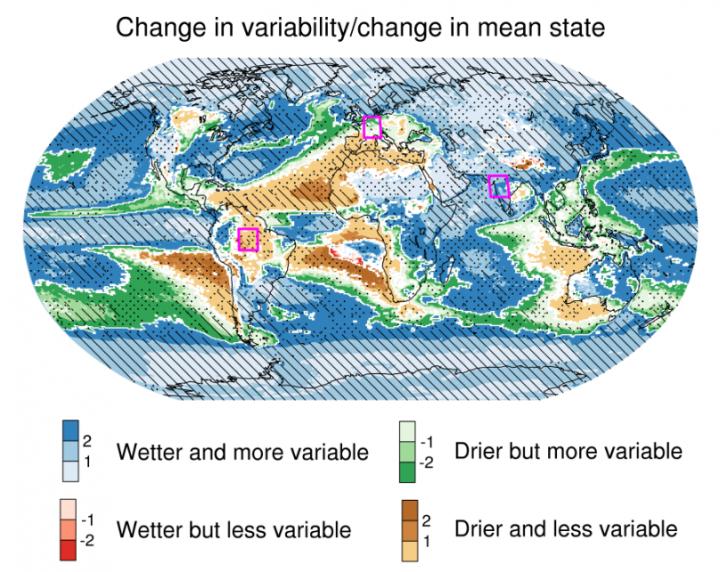Rainfall becomes increasingly variable as climate warms

Classification of precipitation change regimes based on changes in the precipitation mean state and variability. Shading indicates the ratio of change in precipitation variability and mean precipitation.
Credit: IAP
Climate models predict that rainfall variability over wet regions globally will be greatly enhanced by global warming, causing wide swings between dry and wet conditions, according to a joint study by the Institute of Atmospheric Physics (IAP) of the Chinese Academy of Sciences (CAS) and the Met Office, the UK’s national meteorological service.
This study was published in Science Advances on July 28th 2021.
Rainfall plays an important part of our daily life. More leads to floods, less to drought. It has been realized decades earlier that global warming drives increased rainfall on average. How this increase is delivered in time matters enormously. A 2-3% increase of annual precipitation uniformly spreading out of the year does not mean much, but if it falls out in a week or a day, it will cause havoc.
Using large ensembles of state-of-the-art climate model simulations, this study highlights the increase in rainfall variability across a range of time scales from daily to multiyear. Scientists have found that in a future warming world, climatologically wet regions (including the tropics, monsoon regions and mid- to high-latitudes) will not only get wetter on average, but also swing widely between wet and dry conditions.
“As climate warms, climatologically wet regions will generally get wetter and dry regions get drier. Such a global pattern of mean rainfall change is often described as ‘wet-get-wetter’. By analogy, the global pattern of rainfall variability change features a ‘wet-get-more variable’ paradigm. Moreover, the global mean increase in rainfall variability is more than twice as fast as the increase in mean rainfall in a percentage sense,” said ZHOU Tianjun, corresponding author of the study. ZHOU is a senior scientist at IAP. He is also a professor at the University of Chinese Academy of Sciences.
The enhanced rainfall variability, to a first order, is due to increased water vapor in the air as climate warms; but is partly offset by the weakening circulation variability. The latter dominates regional patterns of change in rainfall variability.
By considering changes in both the mean state and variability of precipitation, the research provides a new perspective for interpreting future precipitation change regimes. “Around two-thirds of land will face a ‘wetter and more variable’ hydroclimate, while the remaining land regions are projected to become ‘drier but more variable’ or ‘drier and less variable’. This classification of different precipitation change regimes is valuable for regional adaptation planning,” said ZHANG Wenxia, lead author of the study.
“The globally amplified rainfall variability manifests the fact that global warming is making our climate more uneven—more extreme in both wet and dry conditions, with wider and probably more rapid transitions between them,” said Kalli Furtado, Expert Scientist at the Met Office and second author of the study. “The more variable rainfall events could further translate into impacts on crop yields and river flows, challenging the existing climate resilience of infrastructures, human society and ecosystems. This makes climate change adaptation more difficult.”
The study was supported by the National Natural Science Foundation of China, the China Postdoctoral Science Foundation, the International Partnership Program of the Chinese Academy of Sciences, and the UK–China Research Innovation Partnership Fund, supported by the UK Government’s Newton Fund.
Journal
Science Advances
DOI
10.1126/sciadv.abf8021
Article Title
Increasing precipitation variability on daily-to-multiyear time scales in a warmer world
Article Publication Date
27-Jul-2021
Media Contact
LIN Zheng
jennylin@mail.iap.ac.cn
All latest news from the category: Ecology, The Environment and Conservation
This complex theme deals primarily with interactions between organisms and the environmental factors that impact them, but to a greater extent between individual inanimate environmental factors.
innovations-report offers informative reports and articles on topics such as climate protection, landscape conservation, ecological systems, wildlife and nature parks and ecosystem efficiency and balance.
Newest articles

Innovative 3D printed scaffolds offer new hope for bone healing
Researchers at the Institute for Bioengineering of Catalonia have developed novel 3D printed PLA-CaP scaffolds that promote blood vessel formation, ensuring better healing and regeneration of bone tissue. Bone is…

The surprising role of gut infection in Alzheimer’s disease
ASU- and Banner Alzheimer’s Institute-led study implicates link between a common virus and the disease, which travels from the gut to the brain and may be a target for antiviral…

Molecular gardening: New enzymes discovered for protein modification pruning
How deubiquitinases USP53 and USP54 cleave long polyubiquitin chains and how the former is linked to liver disease in children. Deubiquitinases (DUBs) are enzymes used by cells to trim protein…



